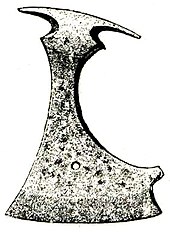Loading AI tools
Axe with a wide cutting edge, particularly on the lower side of the head From Wikipedia, the free encyclopedia
A bearded axe, or Skeggøx (from Old Norse Skegg, "beard", and øx, "axe"), is any of various axes, used as a tool and weapon, as early as the 6th century AD. It is most commonly associated with Viking Age Scandinavians. The hook or "beard", i.e. the lower portion of the axe bit extending the cutting edge below the width of the butt, provides a wide cutting surface while keeping the overall mass of the axe low.
This article needs additional citations for verification. (May 2014) |

This design allows the user to grip the haft directly behind the head for planing or shaving wood and variations of this design are still in use by modern woodworkers and some foresters. The "beard" of the axe would also have been useful in battle, for example to pull a weapon or shield out of a defender's grasp.
Through Scandinavian mercenaries fighting in the Varangian Guard, the design entered the Byzantine Empire. After the Ottoman conquest of Constantinople, the Sultan's guard adopted axes of similar design to underline their continuity with the Byzantine Empire. In the 15th century, these axes would evolve into single-handed bearded axes with a hammerhead on the head. Through Ottoman influence, these axes would spread to Poland and Hungary, where they would become known as "Czekan."


There are a number of variants in its design.[1]
Seamless Wikipedia browsing. On steroids.
Every time you click a link to Wikipedia, Wiktionary or Wikiquote in your browser's search results, it will show the modern Wikiwand interface.
Wikiwand extension is a five stars, simple, with minimum permission required to keep your browsing private, safe and transparent.